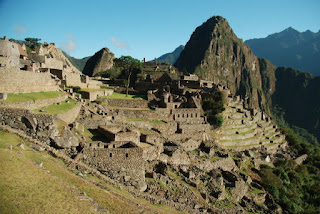On this date in 1911 American
Hiram Bingham discovered Machu Picchu. Here are some facts you might not have known about this fascinating place.
- Bingham didn't set out to find Machu Picchu. He was actually looking for Vilcabamba, the hidden capital that the Inca fled to in order to escape Spanish conquistadors in 1532. While he was looking for Vilacamba, a local farmer showed him Machu Picchu.
- The name "Machu Picchu" means "old peak" in the Quechua language.
- Machu Picchu was built around 1450, at the height of the Inca Empire. It was possibly built for an emperor. It was a military secret, with mountains and cliffs serving as defences, and a secret rope bridge for the army to use to get in and out.
- The city is 2,430 metres (7,970 ft) above sea level, and is built on two fault lines. The Incas apparently knew their stuff when it came to Earthquake-proofing their buildings. The structures were built with a technique called ashlar - stones cut to fit together without any mortar - so not even a knife blade can fit in between them. The stones of Machu Picchu allegedly “dance” or bounce during a seismic event and then fall back into their rightful places. The stones were hauled up without the benefit of wheeled transport. We know the Incas knew about the wheel because there are wheels on some of the children's toys found there; but for some reason they chose not to apply the principle to the shifting of heavy rocks.
- The city was divided into zones - there was an upper town and a lower town, an agricultural zone and a residential zone. There was also a sector used for ceremonial or religious purposes, which contains the Torreón, a massive tower which may have been used as an observatory.
- Other things to look out for while there are the Inti Watana stone, which was believed by the inhabitants to tether the Sun to its path across the sky; the Inti Mach'ay cave which was used to observe the Royal Feast of the Sun. There are more than 100 separate flights of stairs, many of which were carved from a single slab of stone. On rare occasions, spectacled bears have been seen in the ruins; less rarely you might see a naked human posing for a picture or streaking across the site, although this is strongly discouraged by the authorities.
- The most popular way to approach the site is the Inca Trail trek. That's a three day walk at high altitude so not for the faint hearted. Only 500 people can use the trail at any one time, and that includes compulsory local guides. The guides often sleep with a mirror under them when on the trail because they believe it stops spirits from coming up through the ground and abducting them. Many of the guides claim to have felt the spirits trying to pull them out of their tents at times. There is a marathon run along the path every year for which the record time is three hours and 26 minutes.
- There is a little known rule of entry to the site which dictates that no-one dressed in the traditional national costume of another country will be allowed in, so a Scotsman in a kilt, for example, would be turned away at the door. Something to bear in mind before embarking on the three day arduous, haunted trek up there.
- It has been designated a UNESCO World Heritage Site in danger and one of the seven new wonders of the world. There is a no fly zone above it and it is vulnerable to floods and landslides. The entire site was closed for several weeks in 2010 after floods washed away the roads and railways stranding about 4,000 people in the area who had to be airlifted out.

No comments:
Post a Comment